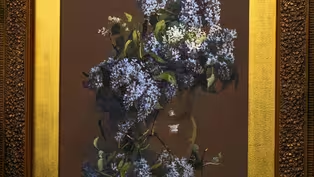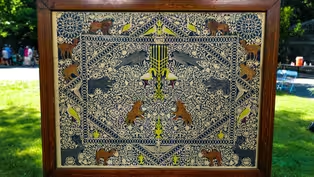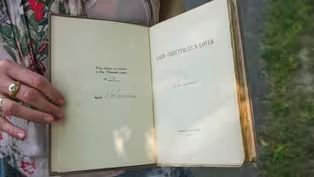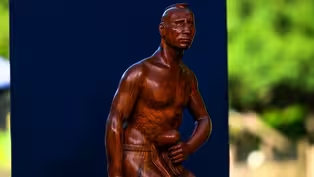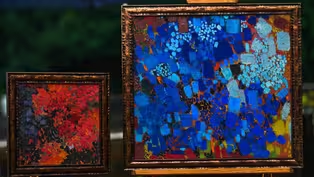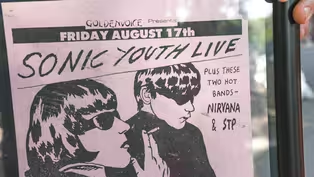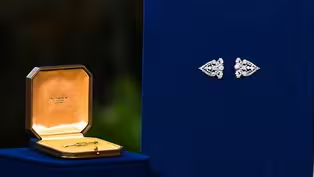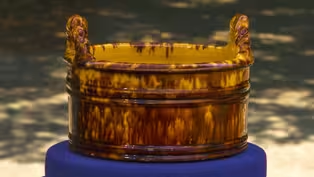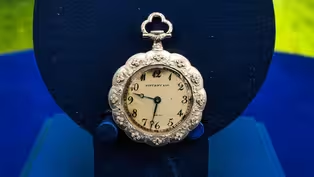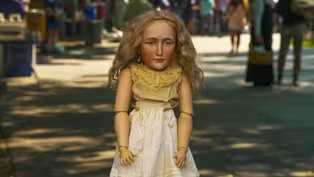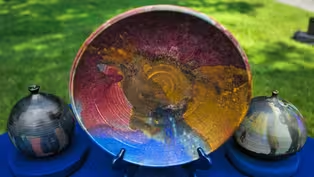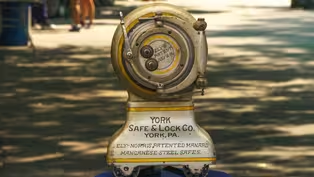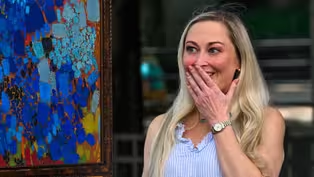
Maryland Zoo, Hour 1
Season 29 Episode 13 | 52m 29sVideo has Closed Captions
Watch astonishing treasures from ROADSHOW’s Baltimore stop! One is $350,000 - $570,000!
ROADSHOW visits Maryland Zoo and finds Lewis M. Rutherford lunar photographs, a Patek Philippe & Tiffany pocket watch and Lynne Drexler oil paintings.
Problems playing video? | Closed Captioning Feedback
Problems playing video? | Closed Captioning Feedback
Funding for ANTIQUES ROADSHOW is provided by Ancestry and American Cruise Lines. Additional funding is provided by public television viewers.

Maryland Zoo, Hour 1
Season 29 Episode 13 | 52m 29sVideo has Closed Captions
ROADSHOW visits Maryland Zoo and finds Lewis M. Rutherford lunar photographs, a Patek Philippe & Tiffany pocket watch and Lynne Drexler oil paintings.
Problems playing video? | Closed Captioning Feedback
How to Watch Antiques Roadshow
Antiques Roadshow is available to stream on pbs.org and the free PBS App, available on iPhone, Apple TV, Android TV, Android smartphones, Amazon Fire TV, Amazon Fire Tablet, Roku, Samsung Smart TV, and Vizio.
Buy Now
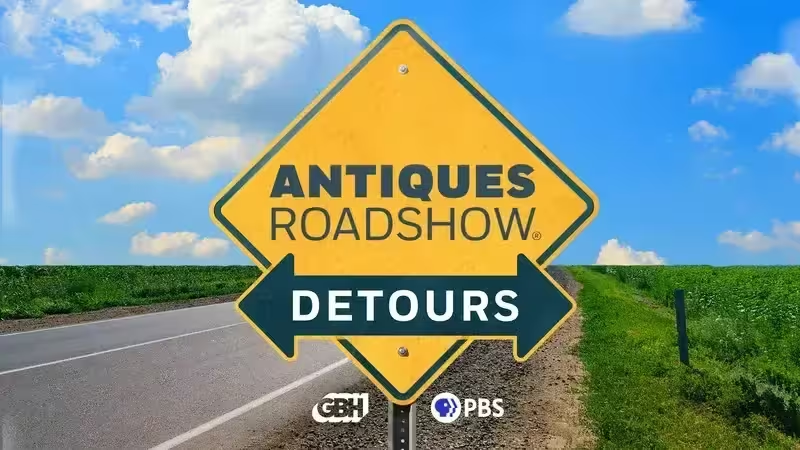
ANTIQUES ROADSHOW DETOURS
Ever wondered what happens to the treasures featured on America’s beloved ANTIQUES ROADSHOW after the cameras leave town? Host Adam Monahan tracks down the juicy afterlives of your favorite finds from PBS’s hit series.Providing Support for PBS.org
Learn Moreabout PBS online sponsorship♪ ♪ CORAL PEÑA: An excited pack of "Roadshow" treasure-seekers has arrived at the Maryland Zoo.
Stopped at a yard sale.
It really kind of caught my eye, and I said, "Would you take seven?
", and she said, "Yes."
Oh, my goodness.
I'm speechless.
♪ ♪ PEÑA: If you're wild about animals and antiques, the Maryland Zoo is a perfect spot for our "Roadshow" event.
The Maryland Zoo is owned by the City of Baltimore, and sits on over 135 acres within historic Druid Hill Park.
Home to over 130 species, the wildlife park is one of the oldest zoos in the United States, having been established by the state legislature in 1876.
Check out the parade of treasures "Roadshow" is seeing at the zoo.
(laughing) ♪ ♪ (cheering) This is so glamorous.
You know, this was clearly a wedding dress, yeah.
Wedding gown, right.
I bought it at a haberdasher off of Piccadilly Circus in London in 1979.
Been carrying it around for 45 years.
I love it, I'm just sad that it's about an eighth- to a quarter-inch too small for me to wear every day.
GUEST: I was on my way to meet a friend to do some shopping.
I was running way ahead of schedule.
Stopped at a yard sale.
It really kind of caught my eye, and I asked the lady how much she wanted for it.
She said ten-- it was really filthy.
And I said, "Would you take seven?
", and she said, "Yes."
Ah.
And so that was last August, and it's been sitting on my, on my bureau ever since.
It is sterling silver.
Wow.
And while it looks like an antique mirror, it is not an antique mirror at all.
It's just...
It is not!
It is not!
It's a very lovely reproduction...
Okay.
...made in 1997 in London.
Wow.
So it isn't terribly old, but it looks like it's made 150 years before that.
The reason I can tell you that for sure is that it is very clearly marked right down here.
You probably can't see it, but it's tiny, tiny little marks right there.
There is a lion, meaning that it is sterling silver and made in England.
Oh, my goodness.
There is a leopard's head, meaning that it was made in London, specifically.
Okay.
There is a letter to correspond to the year 1997.
And then there are the maker's initials for Neil Lasher.
This is a technique called repoussé.
Wow.
And repoussé is a technique where they have a design that is molded or carved... Wow.
...and they take a flat piece of silver and they hammer the decoration into the mold to create this three-dimensional effect of these flowers.
He made a lot of these, and the auction records show... Yeah.
...a lot of them of various different sizes.
Wow.
Also picture frames without mirrors in them.
This one is, is rather large.
A lot of them are smaller, but this is a nice, good size.
Wow.
And the silver is very thick on it.
It's in remarkably very good condition.
If I were to see this come up for auction, I would expect it to bring in the neighborhood of $500 to $700.
Wow!
That's fantastic.
(laughs) Well... That is fantastic.
I am just blown away and extremely surprised.
Wow, thank you so much.
Well, I want to go shopping with you.
(both laugh) Wow, that is fabulous.
Uh, well, all I know is that it was probably my great-grandmother's, um, but it does have a label on the back, or under it.
So I'm hoping that maybe we can find out a little bit more.
I can't tell you a thing about it.
I've had it 50 years and know nothing.
I got it in California at a swap meet.
(exhales): Maybe five dollars.
GUEST: This was given to me by my father.
He got it from his father, who was an antiques collector.
I got it in 1993.
It was appraised at that time at $200.
$200, okay.
I was told that it is a John Bell butter tub, and that's all I know about it.
(laughs) Okay, well, you're correct, it is a butter tub.
This probably dates to around the 1840s, '50s, '60s, somewhere around there.
And it was incredibly utilitarian.
It was made just to use in the kitchen.
It was never intended to be an heirloom or collectible or to pass down.
It was just something to use every day.
Okay.
Now, back then, butter, of course, did not come in a package at the grocery store, in a stick.
You would either churn your own butter or you got it from local farmers, and you had big blobs of butter and you kept it in this big pot.
When you brought it out of the box, I thought, eh, you know, it's okay, it's an old piece of American pottery.
Right.
It has what we'd call a Bennington or a Rockingham glaze, which is kind of a tortoiseshell glaze.
Okay.
The base pottery is kind of a yellowish color.
Yes.
Then they put on this kind of mottled, sloppy, brown glaze.
And it was just a, a way of making something to use every day in the kitchen that was a little decorative, but it was not expensive.
If it were j, unmarked, it, it might sell for $50, or maybe $100.
Right.
But we've got something going on here that makes it a lot more interesting.
As you mentioned, it is made by a man named John Bell.
Do you know where John Bell lived and worked?
I read that he was born in Hagerstown, Maryland.
He relocated to Chambersburg, Pennsylvania, but he had his pottery shop in Waynesboro, Pennsylvania.
Okay.
He's from a, a l, big family of potters.
Okay.
He learned pottery-making in the German tradition from his father.
Now, he worked pretty much from about 1833 to 1880, when he died.
These things got chipped, they got cracked, the handles got broken off.
They didn't really survive in very good condition.
Right.
But this is one of those remarkable survivors.
If this were to be sold at auction, it would probably sell for between $3,000 and $5,000.
Wow!
Oh, my, I did not expect that.
Wow, I, I'm, I'm shocked.
We did find an auction record for a nearly identical one with a little different colors that actually sold for $6,000 at auction.
Wow.
GUEST: The family story is, my great-great-grandfather helped a family that lived in Connecticut move, and the payment for helping them was this painting.
APPRAISER: What year would this have been around?
'40s?
'30s?
Oh, wow, okay.
And it's been hanging in our dining room for the last 14 years.
Oh, wow!
Yeah.
Well, that's really, really neat.
So obviously, you cherish it, because you have it in a... We do.
...place of honor.
We do, yep.
And who is the artist?
Elizabeth Nourse.
I know that she was from Cincinnati, Ohio... Mm-hmm.
...or a small town outside of there, moved to Paris, and that's really all I know.
Well, yes, she was born in the Cincinnati area in 1859, and ultimately ends up in Paris, where she, uh, passes away in 1938.
In her early career, she started out in Cincinnati, moved to New York, like many artists might do, and studied with an artist named William Sartain.
And she also knew the well-known painters William Merritt Chase and Julian Alden Weir.
She briefly goes back to Cincinnati, but like most artists, really wanted to go abroad.
And so she moves to Paris to study at the Academy Julian.
She was very much admired by the critics in Paris.
And so in the Paris Salon of 1900, they actually called her an artist, not a woman who paints.
She was one of the first American women to become a member of the Society Nationale des Beaux-Arts in 190l, so that was also quite an achievement for her.
And so what we have here is a gouache on paper.
And you can see that it's on a rather brown paper.
Originally, the paper would have been a tannish color, but over the years, because of the content of the paper, it tends to discolor.
So it's not really damaged.
It's just something that's inherent to the paper.
And of course, it's a beautiful rendering of lilacs.
Mm-hmm.
And you can see that in the lower left, she's signed with her initial E., and it's dated '85 for 1885.
The frame is magnificent, and the floral design along the edges really emulates the lilacs in the piece.
And so perhaps it was chosen just for that reason.
And this kind of elaborate frame was very popular in the 1880s and '90s, as well as this interesting gold-leaf mat.
It's an excellent package.
Women artists are now really the bill of fare, are very popular.
The issue with Nourse is that she was painting a lot of European subjects, and particularly her peasant subjects are not necessarily what Americans are collecting today.
And mostly her work is collected by Americans.
So her, her market's fallen off a little bit.
But that being said, she, she is highly revered and there still is interest in her work.
And if this were in a gallery, either in Cincinnati or in New York, I think that it would sell in the range of $15,000.
Cool.
I'm happy with that.
So I got this, um, a couple of years ago at a antique store, and I just loved it 'cause it's got a cat on it, so it was really pretty.
It was something different.
And the owner, uh, she really liked it, but she said, "Well, it's time for me to part with it."
And so she offered it for sale and I bought it.
I talked her down from $150, so I think it was, like, maybe $75?
GUEST: When I was in high school, I read, secretly, "Lady Chatterley's Lover."
And then, when I was in my 30s, a boyfriend said, "Oh, you should read this."
I said, "I already have, I've got a copy."
(laughs) And then I was at a flea market-- I know, a great boyfriend.
And I was at a flea market in New Jersey and I found it in a box with a bunch of other books, and I just grabbed it 'cause it said "Lady Chatterley's Lover."
Yep.
And I only had my paperback edition, so I... Do you remember what you paid?
A dollar.
A dollar.
And you noticed that it's signed by D.H. Lawrence.
Yes, yeah, I was...
It was printed in 1928, it was, it was censored.
Didn't really come out with all of the juicy bits until 1960.
Mm-hmm.
So not everybody is familiar with this book.
How would you, uh, sum it up or synopsize it?
(exhales) Well...
Younger woman, older, uh, disabled man, um...
It's adult-themed?
Yes, yes, yes.
Yeah, adult-themed, yeah-- right.
It's, it's juicy.
Do you have any idea about value?
Have you ever looked it up or tried to figure it out?
Wasn't in, I just, like, you know, it was something that was kind of personal, so, no, I have never... Well, this is, this is kind of the way people want it.
And if you were, like, "You know what?
I have a friend, maybe I'll get another one," how much do you think you'd have to spend to get one?
I don't know, a, a, a couple hundred dollars?
I, I honestly have no idea.
If you wanted to buy one just like this one right here, and you went shopping, you would have to spend $12,000.
Are you serious?
Mm-hmm.
Even in the condition... Yeah.
Oh, my gosh, Devon.
Whoa, that's crazy.
Yeah, that's pretty cool.
I mean, that's crazy, right?
At auction, it's less.
It's more like $4,000 to $6,000.
But if you wanted to replace it, you'd have to pay $12,000 to $17,000.
That's crazy, that's amazing.
Like, I, I just... Somebody said, "Don't bring, like, um, paintings."
Like, "Bring something more inte..." So I went in my library and I was, like, "Oh, I'll grab this."
"I'll just grab this $12,000 book I have on my shelf."
But I... (laughing) No, seriously!
No, it's awesome.
Devon, thank you-- I had no idea.
Yeah, my pleasure.
PEÑA: Modern zoos, like the Maryland Zoo, are educational and conservation centers designed to reflect animals' natural habitats.
Although they are no longer in use, many of the zoo's earliest structures still remain to illustrate the evolution of zookeeping.
We kind of had this time capsule left in the heart of the zoo that many zoos didn't have.
It was only recently opened back up so visitors could walk through it and gain an appreciation of the zoo's history and how far we've come.
GUEST: My grandfather was a salesman for the York Safe and Lock Company.
It's my understanding that he used to lug this model around... (chuckles) ...to prospective customers, trying to sell them full-size vaults and safes.
'Cause it's so heavy, my mom was afraid to put it up on the shelf... (chuckles) ...for fear that it would fall.
It's always been a conversation piece.
It is a, a little gem, honestly.
It's what we would call in the trade a salesman sample.
It's got all the company information on it.
York, uh, Safe and Lock Company, York, PA. And then it has a patent date of July 31, 1906.
It's actually a working model, it's not just a, a toy model.
It's, it's got-- it's so highly detailed.
It's meant to represent the full-scale model.
So we open the door and we can see the interior is exactly like the full-scale would, would appear, with this glass over the mechanism, so you could see it working.
And that inner part would rotate to lock it inside the cabinet here.
And it's even fitted with shelves inside.
The patent on this was because of the c, the circular design.
Most safes at the time, especially if you watch cartoons... (chuckling): ...are big t, rectangular things that fall on your head.
But those were easy to break into with explosives.
This was harder to do with explosives because of the round shape.
It would deflect a lot of the blast, and even if you did, you, you'd likely not be able to get into it like you could a paneled safe that would have had welded sides, and in fact... Close it back up, and we look on the back, it has this decal, which tells us it won the highest honors at the Panama-Pacific International Exposition.
What's great about this is that it says "manganese steel safe."
So manganese steel is a special kind of steel.
It's less brittle than traditional steel.
It's also non-magnetic.
In fact, it was used during the war for soldiers' helmets so it wouldn't interfere with the compasses.
Another selling point that they had painted on the front.
A little bit of wear, but just enough wear to make you know it's, that it's period, but not so much wear that it's lost some of its value because of, uh, of the loss of the design.
Your grandfather carried it around for many, many years.
And actually we have a picture of him, too.
Is he, he's right, standing in front of a larger version of this, with a circular door.
Mm-hmm.
That's him.
Did he ever talk about it?
No-- unfortunately, he passed before I was born.
I think it also had a case, at one point, that he would carry it around in.
Is that anywhere in the attic?
That's... (laughs) No, that's, that has never been... As long as I can remember, it was just this item.
Got it.
If this were to come up for auction today, I think a reasonable auction estimate would be $30,000 to $50,000.
Oh, my goodness, that is... (laughs): That's amazing!
It's a gem.
And I might actually build a shelf for it now.
I love it.
That is remarkable.
GUEST: I found it at a thrift store in Watertown, New York.
APPRAISER: A thrift store in Watertown.
In Watertown.
What did you like about it?
I realized that it's the paper cutting, and it's very intricate.
Okay.
And it's got all the animals and the menorah.
Mm-hmm, right.
And the lady that did it, her name is down here somewhere.
Okay.
And I don't know if she put the city or not.
Right.
But it's dated.
Okay, well, what did you pay for it?
About five dollars.
Five dollars.
No more than ten.
Okay.
You know it's a paper cutout.
Right.
But I don't know if you knew that there was a tradition, a Jewish tradition... Mm-hmm.
...of making these paper cutouts.
The contrast of the colors is wonderful.
Mm-hmm.
And right in the center is an American eagle with a shield.
Mm-hmm.
So, patriotism.
Right.
American patriotism.
So have you ever tried to figure out what this says?
'Cause this is a Hebrew word here.
I haven't.
This is the Hebrew word for "east."
Okay.
And I, I believe it's pronounced "mizrach."
In the Hebrew tradition, the, this would be placed on the east wall.
So you have these two sentiments, one of great reverence for one's religion...
Right.
...and great reverence for one's country.
It's really great folk art.
It is-- I loved it.
It's also great Judaica.
Yes.
And you have a pretty good eye, you, 'cause you also bought something with the original frame...
Right.
...and with the original backing...
Yes.
...on it.
I'm going to very carefully take this out.
I, I've got it.
Okay, mm.
Gonna flip it over like this.
And the cool thing is, you have "Albany, New York, Friday, August 16, 1918."
So the war wouldn't be over for, till November.
You have the original newspaper, and it's been preserved underneath the backboard all this time.
Mm-hmm.
It's really like a time capsule, right?
It is.
Let's come back to the work.
There's one more thing I-- I'd like to point out that this is the artist's name.
Right.
And I haven't been able to find this yet... Mm-hmm.
...but there might be other works that this paper cutter has done.
Oh, okay.
There are several very famous Hebrew paper cutters, and the, works by them bring a lot of money.
So I can put a retail price on this.
Okay.
What do you think I'm going to say?
Want to, do you want to guess?
$200, or $2,000.
$2,000, that's a good guess, okay.
Multiply by ten.
Do what?
$20,000.
Okay, great.
Retail price.
And that wouldn't be hard to achieve, it really wouldn't.
Okay, sounds good.
Not bad for... Not bad for a thrift store find.
Well, it was my great-grandfather's, and it's handmade, and, uh, it actually was used as a pitchfork.
Um, I don't know the wood, but, uh, the guy said that it was in good condition for how old it was.
We, uh, bought it in Alabama about 30 years ago at an auction, and we always thought it might be a reproduction, but we weren't sure, so we just thought we'd come and get some expert opinion.
Well, my grandfather was a, a donor to Bacone College, which was a Native American college in Muskogee, Oklahoma.
And one day, he put me in the car and we went to Bacone College, and we came home with this.
And, um, his friend Dick West carved it.
And, um, I don't know, like, if he commissioned it or if he just saw it, liked it, bought it.
It's a really wonderful example by Walter Richard West, who was the head of the art department at Bacone College in Oklahoma.
Mm-hmm.
He's not really known as much for his sculpture.
He, he was a painter.
His paintings are represented in the, uh, Gilcrease Museum.
He also has paintings in the Philbrook Museum... Yeah.
...which is in Oklahoma.
So what we're really looking at here is a wonderful example, and I, I can only use the word "rare."
I'm really impressed with its scale.
I'm really impressed with just the portrait itself.
When you look at that profile, you get a real sense of-- at first I thought, that's a Mohawk, right?
That's what I thought.
I thought he was a Woodland Indian.
Yeah.
But it probably isn't a Mohawk-- it's probably a roach.
You'll see that it actually scoops down, and there's a little indentation in there.
So this would have been attached up to, on the top of his head, and then it would have horsehair that would be coming off the side of it.
Oh, cool.
He's got a, a long loincloth, he's holding a rattle, um, and the title being "Coyote-Warrior," it's up to interpretation.
We can use sort of a pan-Indian identity without being too specific, because it's hard to identify without having the artist here to really explain the narrative of it.
Mm-hmm.
Right.
But the provenance is really wonderful.
What was it originally purchased for?
I think it was $250.
Is that what it was?
That's a deal, I think, right?
I, I think it's a steal of a deal.
Yeah, that was way back when.
Yeah.
That might have been a lot of money.
(chuckles): It might've been, back then.
In 1959.
Yep.
I would say that this, for insurance purposes, the value of this would be between $25,000 and $30,000.
That's a motorcycle.
(chuckles) That's a Harley.
Yeah.
Wow.
GUEST: Well, I used to live in Wellesley, Mass.
The town dump has a great recycling area, and I wanted some frames for posters.
So I picked these up for the frames.
And when I got 'em home and saw what they were, uh, we reframed 'em with acid-free paper to preserve 'em, and they've been wrapped up in a closet since about 1986.
(chuckles) So you've never hung them.
I thought they were interesting, and I didn't want the light to destroy 'em.
Okay.
And we didn't have controlled humidity.
I wanted to take care of 'em.
Well, the great thing about these is that they're very, very rare.
They are made by Lewis Rutherfurd, a man who was known as one of the greatest lunar photographers of his age.
So these photographs would have been something that was made for fellow astronomers for scientific use.
So they wouldn't have been something that would have been out on the market for just everyday people.
And therefore, they would have been made in smaller numbers, um, and that's why we really don't see that many of them.
He made these photographs in 1865, and we know that because he's actually written his name here on the negative and then also put the date here.
So what's really interesting about the photograph on the left is, we also know, um, the time of day that they were taken.
Oh.
So you have the date here, January 20, 1880.
And then you have 8:47 GMT, which is Greenwich Mean Time.
Mm-hmm, uh-huh.
So about 3:47 New York time, which is where Rutherfurd was working... Uh-huh.
...in his backyard observatory.
We have an inscription on them, as well, because it tells who he gave these to.
B.A.
Gould.
And that would have been his friend, who was another astronomer.
Hm-hmm.
And they were great friends.
Such good friends that, after Rutherfurd died, Gould was the one that wrote his memoir.
There is some loss here, and that may just be because of exposure to some humidity or heat.
It's hard to tell why that happens.
But they're old photographs.
And that's what happens sometimes.
The good news is that the color is just so rich and beautiful.
And a lot of times with these albumen prints, the colors tend to get very yellow and faded.
Mm-hmm.
And what we have here are these really beautiful chocolatey tones in the darkest areas.
And the highlights are pleasingly yellow.
They're not, you know, sort of an acidic yellow that you sometimes see with older photographs.
So they're in really lovely condition.
An auction estimate for the pair would be $4,000 to $6,000.
(mouths) (chuckles) (laughs) Pretty good for a dumpster dive.
It is.
PEÑA: The Maryland Zoo is the third-oldest zoo in the United States.
Built in the late 1800s, the round cage was considered state-of-the-art when it was constructed and is the oldest exhibit at the zoo.
Bears were often kept here, although hyenas were the last occupants, in 1993.
GUEST: My father was in Cornish, Maine, in a resale shop.
I was just about to graduate from college about 20 years, 20-plus years ago.
My father ended up paying about $60 for this piece and, uh, gave it to me for graduation.
It's a poster for an exhibition that Robert Indiana had of his works at the Stable Gallery in New York in 1966.
So this is, in fact, a poster from 1966, authentically from that era.
Really?
Wow.
(chuckles) It was his third exhibition at the Stable Gallery.
Historically, that's been referred to as "the LOVE Exhibition," and it was referred to as "the LOVE Exhibition" because it was the first time that he publicly displayed his "LOVE" paintings.
Wow.
And these "LOVE" paintings have really become such an iconic part of the American cultural landscape.
They've been on postage stamps, they're statues, they exist in paintings, all different sizes and colors.
The artist first came up with the idea in 1964, and he sent a holiday card to his friends with the "LOVE" logo on it.
The next year, in 1965, he designed a Christmas card for the Museum of Modern Art in New York... Mm-hmm.
...which they still claim to this day was their best-selling Christmas card ever.
Wow.
And then the following year, when he had his third exhibition at the Stable Gallery, he designed this poster.
So, I'm a poster geek, and I say that very proudly.
(chuckles) And for me, this is the first poster representation of this iconic American artistic form-- the first time that "LOVE," the Robert Indiana "LOVE," appeared in a poster.
The colors are still really bright.
And the predominant colors, which fit in so beautifully here... (chuckling): Yes.
Right?
Are the green, the blue, and the red.
And a lot of people posit that these colors represented for the artist Phillips 66, the petroleum company-- his father worked for the company.
Oh.
And their neon sign above Indianapolis, where he lived, had these colors.
So they say that that was perhaps what influenced him in this first series to use the red, green, and blue as the predominant colors.
That's amazing.
A lot of Robert Indiana's posters were mass-produced.
They were done for exhibitions at larger museums.
Mm-hmm.
So they have lesser value because there's more of them.
In this case, the supply is not that big.
The Stable Gallery was not a particularly big gallery.
We don't actually know how many were printed.
Mm-hmm.
But we know that not that many have survived.
Wow.
It's done, uh, via a process of screen printing, which is also a, a process by which not that many could ultimately be made-- there were probably a few hundred or maybe even a thousand, that would be my, my guesstimate.
When these come up for auction nowadays, you can expect them to sell for between $2,500 and $3,500.
Fabulous.
Every once in a while, you see one of these posters that's also hand-signed by him.
And in that case, the price would be almost doubled.
GUEST: This is a brooch that turns into gown clips.
It was given to my aunt, her second marriage-- met a man who was the heir to a Midwestern beer fortune, and this belonged to his mother.
Did she ever wear them?
No, not to my knowledge.
(both laugh) I think it was just too much.
She probably put it on when he gave it to her and then that was, that was the end of it.
My sister, who just passed away recently... Mm-hmm.
...had been in possession of all the, all the jewelry from... Mm-hmm.
...all sides of the family.
And when she passed away, um, being the last one standing, I... That's when I got it, about two years ago.
Mm-hmm.
So, these are one of my favorite types of jewelry.
Mm-hmm.
And they're called dress clips.
And it was a new form of jewelry introduced in the '20s, and it was a reaction to changing dress styles for, for women.
Mm-hmm.
It went from these very buttoned-up, corseted Edwardian dresses to these free-flowing flapper dresses.
And they needed a different type of jewelry to go with it.
So they invented the dress clip.
And the dress clip is great because it can be worn as an old-fashioned brooch.
Mm-hmm.
And it's great.
It comes with the original pin fitting here, and they could go together and form a plaque brooch.
But that wasn't the fun way to wear them.
(laughs) The fun way to wear them was to separate them.
Mm-hmm.
And women would wear them on either side of their dress.
And then some women would wear them on their fur coats, some women would wear them on their purses, some women would wear them together, apart.
It gave a lot of versatility and informality.
They remained popular until the '50s, and then they started to fall out of style and the traditional brooch came back in.
Right.
And by the '60s, they weren't really made anymore.
So they're just a, kind of a small time in j, jewelry history.
They're made of platinum and diamonds.
The diamonds are a mix of cuts.
You have some old European cuts, some baguette cuts, and some single cuts.
What's great also about these dress clips is, they use larger stones.
There are several stones in these that are over one carat each, which is rare to find in dress clips.
Wow.
And they were made by a firm called F. Walter Lawrence, which was founded in the late, um, 1800s... Mm-hmm.
...and continued for about 80 years in New York.
And F. Walter Lawrence first started with Arts and Crafts jewelry.
And he was very interested in making jewelry that would function as sculpture to wear, that it would be art and it would be interesting.
Mm-hmm.
And you can see that carried forward in these dress clips.
And you're very lucky, because you have the original box.
It's good that you have that, because they're not signed.
Hm.
And not all pieces of F. Walter Lawrence jewelry are signed.
Ah.
And when they're not signed... Mm-hmm.
...we really can't attribute it.
Right.
So it's really wonderful that the original box has stayed with it all this time.
That really does help the value.
Mm-hmm.
And that probably increases the value of the piece by at least 20%.
Oh, my.
They're beautiful, they're well-designed, and the diamond weight is significant.
Mm-hmm.
You have over ten carats of diamonds in these clips.
Wow.
So I would insure this at the $30,000 mark.
(whistles softly) All right.
Well, thank you so much.
That's, that's good to know.
For years, it sat in a safe deposit box, and we always wondered about it.
We knew it was spectacular, but...
Didn't know it was that spectacular.
(chuckles) Um, they said it is a, um, Supro electric guitar.
Uh, nine, early 1950s.
It was in my mom and dad's attic for probably 50 years, not touched.
So, as a child, I desperately wanted a dog.
And my parents traveled all the time and wouldn't allow me to have one.
So they brought this back from England...
Okay.
...uh, 35 years ago.
Okay.
I know that it, uh... Well, it growls, which is fun.
(growling) Very cool.
Um, and I believe it's papier-mâché.
And outside of that, I don't know much.
Working well, that's great.
Um, it's authentic, so I'm happy to report that.
They did reproduce this.
Okay.
Um, and even the reproductions are still valuable, but they're not as valuable as the originals.
Uh, an auction estimate-- and conservatively-- would be $1,000 to $1,500.
Excellent.
(growling) GUEST: My mother-in-law made these shadow boxes for each of her four sons after their father passed away.
They each contained different medals and photos that she had reproduced in there.
Who is this individual to you?
Uh, Jacob Beser is my father-in-law.
Tell me about what he did in World War II.
He was the, uh, radar countermeasure.
He controlled whether or not the bomb would detonate in air.
He did both missions in Hiroshima and Nagasaki.
That's got to be a fairly rare thing.
It is-- he was the only man that did both missions.
He, um, considered it his job to the United States.
He joined right after the bombing of Pearl Harbor.
And his whole speech was that he would hope that this would never happen again.
He is, um, the only Jewish man in Baltimore that participated in the bombing, so, he was very concerned about what was going on during World War II.
You've got her copy of the photograph, because we saw the original in the material.
We've got the newspaper bit for context.
And then down here, his miniature medals: the Silver Star, the Distinguished Flying Cross, the Air Medal, American Campaign, Asiatic-Pacific, and the World War II Victory.
But the real stars of the show are these two pieces here at the very bottom, this little leather band and I.D.
bracelet and, more so, the identification tag.
And the reason why those have more significance than the medals is because those would have been on his person when he flew those missions.
To put a value on this could be perceived as disrespectful.
It is not intended in that way.
It simply reflects the position of the item within the demand for extremely historical military memorabilia.
We discussed it at the table amongst our colleagues and believe that a conservative auction estimate for this, just what you see here, would be between $3,000 and $5,000.
Wow.
That's amazing.
Well, it'll always be with the family.
This is really a window into a pivotal moment in world history.
Well, my-- this belonged to my mother-in-law, and I th... She bought this maybe in the '60s?
She kept telling me, you know, "This is a very good thing, it's amphora."
And that's what I heard for, like, 40 years.
Oh, it's not my... (both laugh) It's not my favorite.
But I, I'm not g, you know, I don't want to get rid of it.
So I guess I do like it, because I keep it.
So... She likes it enough to keep it.
She was very into pink and green.
That's why this probably appealed to her in the first place, so...
GUEST: My father had bought it for my mother back, 1970.
In that time frame.
My father had been a, a Shriner and a Mason, and he created a lot of contacts through that.
And so he met Larry Beck, who was the trophy king of Baltimore and also a jeweler.
And he would buy his, uh, jewelry from Larry.
And so, if there was things that Larry Beck thought my father would be interested in, he would call him and have him come out and take a look, which is how I'm pretty sure this watch came to be.
Um, my mother used to wear it as a pin when she would go out to dance or dinner.
Is there another piece to it, then, that made it a pin?
There used to be another piece, but it wasn't part of the watch.
And two jewelers had offered me $2,000 for that.
Okay.
And I just wasn't ready to sell it at that point.
I just felt like there was something more to that watch than what they were saying.
Do you have any idea how much your dad paid for the watch?
I do not know.
I mean, I was, I was a kid.
So your dad sort of hit the trifecta when he caught the watch.
The watch is platinum, it's made by Patek Philippe, and it was retailed by Tiffany.
Tiffany was the first company in the United States to become an authorized franchise agent for Patek.
So, Patek-Tiffanies are steeped in American history in watchmaking.
The watch was made circa 1910.
And we can tell that from the serial number that is on the movement.
The case and all the diamond work was all done in France.
It's an 18-jewel movement.
It's encrusted with diamonds.
So here's the face of the watch, which is Tiffany and Company.
Diamonds are going all around.
And then, to open up the watch, we take off this part of the case.
And this is the inside cuvette, or dust cover.
Okay.
And what you see is white enamel.
And on the other side, you see the high-karat, 18-karat yellow gold.
On the back is a case number, is a hallmark, which is a French duty mark.
Now, the movement is also signed Patek Philippe, 18 jewel, and a serial number, and also has the marking "Tiffany and Company."
Tiffany sold other brands of watches, Patek being the Rolls-Royce, the finest that they did.
They, they had five or six different lines that they used.
A lot of the Tiffany watches are unsigned on the movement, meaning that you don't know who made it.
It was just retailed by Tiffany.
But with the franchise agreement that Patek had with Tiffany, it's signed on the movement, which brings it to a whole 'nother level.
In today's market, at a retail level, this watch would be in the $13,000 to $15,000 price range.
It's an absolute extraordinary example of a Tiffany Patek.
Wow.
Congratulations!
Thank you!
(laughing): Oh, my goodness.
Now I know.
KATELYN NEWELL: We have two giraffe here at the zoo.
They're both reticulated giraffe.
We have a male and a female.
Their names are Caesar and Kesi.
Giraffe in the wild would live in a open kind of savannah.
Giraffe tend to eat mostly from the trees, so they're going to be browsing on the leaves and the branches, um, but they will, too, sometimes from bushes or grass.
They are mostly located in the east and southern parts of Africa, um, but they are kind of spread all over.
GUEST: She's my paternal grandmother's doll.
And when was your grandmother a little girl, what time period?
Uh... 1900.
And I don't really know when she actually got this.
So you inherited it-- um...
Yes.
Did, the other family members were involved in that, or... Well, they-- none of 'em liked it.
And why is that?
They didn't like the face.
Nobody else wanted it.
And I w, that was the only thing I really wanted out of her estate.
Oh, you're my girl.
(both laugh) So they didn't like her face?
Why, though?
I don't...
They thought it was haunting.
Oh, the creepy doll syndrome.
Mm-hmm, yeah.
She was made by a German company, Simon and Halbig, and she's mold number 152, and she was made some time in the, uh, 19-teens.
She was actually made as an exhibit doll, and it's believed-- we don't have firm documentation, but it's believed by many doll scholars-- that she represents a historical figure named Rosa Luxemburg.
Oh, my heavens!
You have a name now!
Yes, she does.
(laughs) She was born in 1871, in Poland... Oh!
...as a Jewish girl.
Rosa had a limp.
A disability, actually.
Oh.
And she limped her whole life.
In those times, being disabled... Oh, yes.
...you were kind of scorned and you just kind of stayed home.
(murmuring) Ostracized.
True.
And Rosa?
No.
She was a human rights activist in Germany.
Ah.
She's very anti-war.
She's all about the common man.
She was in jail several times for her writings, and even died for those beliefs.
And one of her biggest things was the January event in 1919, which was a bloody several days.
Mm.
And that-- and of course, then after that, she was killed.
But they still celebrate her in Germany to this day.
Oh, gee.
Thousands of people.
I've only seen four or five of these dolls ever.
And in pictures.
Uh-huh.
This is the first one I've had in my hands.
Uh-huh.
And all the others-- Joan of Arc, all the other Rosa Luxemburgs-- all have blue eyes.
And here you have the one and only one that I know about in the world with brown eyes.
(chuckles) That is so rare.
We call them intaglio eyes because they're not just flat painted eyes.
Yeah.
If you were to actually touch the doll, it indents a little bit.
Uh-huh.
And that makes it look a little bit more realistically human.
She's got a highly characterized face.
She's obviously an adult woman.
Yes.
And Simon and Halbig made beautiful character dolls.
And her head is made of fine porcelain bisque.
Her body is wood and composition, and it's ball-jointed so that you could pose her.
She has pierced ears, and this was a typical Simon Halbig thing to do.
The earrings have been replaced in a very colorful fashion.
(both chuckle) It's not her original undergarments, but definitely antique undergarments.
Uh-huh.
And let me tell you, folks, this wig is divine.
She has her beautiful original antique mohair wig.
Uh-huh.
In outstanding condition.
And then the other thing is...
Her bisque is perfect.
We've got a little glue residue on the forehead, probably when the wig was glued on.
Uh-huh.
And then we have a little bit of foot damage.
Her retail value will be somewhere between $22,000 and $26,000.
Wow.
Wow.
Thank you, I...
I mean, that's amazing.
(laughs) One just recently came to auction, and she sold for $90,000.
Whoa!
GUEST: I brought three pieces of pottery.
I remember them from my early days growing up in Cleveland, Ohio.
APPRAISER: Mm-hmm.
And after my parents passed away, my siblings and I divided up the pottery, and we each got s, at least one moon pot, which I think is this form.
And then I liked this bowl in the middle, and I just thought it went with it.
(chuckles): And so I took it.
This pottery was always referred to as Toshiko moon pots.
I didn't know if this was a Toshiko in the middle.
But I just loved it.
All three pieces are by Toshiko Takaezu.
Oh.
Toshiko Takaezu is a, a major figure in not only American ceramics, but American art.
What's happened recently is, it's not only that her pots are being appreciated, but she's seen as an Abstract Expressionist.
So there are museum shows all over the country of Toshiko's work.
Oh, really?
In addition to being a potter, she's a woman of color.
She's a woman artist working the Abstract Expressionist style.
So, pottery is not always just pottery.
She was someone who covered a lot of different territories.
She trained at Cranbrook Institute... Mm-hmm.
...studied under Maija Grotell, who was one of the great ceramic artist figures of the 20th century.
She taught for decades at Princeton University, ceramic arts.
Huh.
And she had a studio about 20 miles from where, um, we're located.
I had the pleasure of meeting her once.
Oh.
So you have three different expressions of Toshiko's work here.
First, as you say, you've got a moon pot.
Yeah.
Which is a very important idea in and of itself.
She believed that her enclosed pots like this were very spiritual.
They enclosed the universe and they enclosed our inner selves, so there was a spiritual connection.
Mm.
And you could see from the way this is painted, in terms of Abstract Expressionism and her use of color, which is something that really, early on, we never associated with Toshiko.
The piece closest to you is not clearly signed, and I'll show the marks on the ones that are.
I'm sure it's her work.
And finally, this bowl.
I mean, she's known for her enclosed shapes, but this is a beautiful bowl, not just with good size to it, but if you want to talk about Abstract Expressionist use of color, this is a great example of how she blended colors.
So these are earthenware.
She worked for a long time.
I, I'm inclined to think that these are probably from the mid-'60s to the mid-'70s.
The one here has a more typical mark, which is the "TT" incised into the bottom.
Ah.
The one in the middle has a, a less common mark.
The "TT" is painted onto the bottom, for Toshiko Takaezu.
And this one, I cannot find a mark on it.
But if you compare the bottoms of these two pieces... Mm-hmm.
...it's the same bottom, it's the same clay, it's finished the same way.
Nobody would doubt that this is her work.
They may pay a little less because of it not having a mark.
Because it's not signed, okay.
How much did your parents pay for these?
Nothing.
They were gifts?
My uncle was part of that group... Uh-huh.
...of Cleveland artists in the '60s, and they've just been there and together for as long as I can remember it, and I'm sure they didn't buy them.
Her prices have exploded.
At auction and through gallery sales recently.
Auctions were selling Toshiko pieces like this one four years ago.
This would be estimated for maybe $2,500 to $3,500.
Now this is $6,000 to $9,000, $7,000 to $10,000 at auction.
Wow.
This pot here, even without a mark, I would have estimated this four or five years ago for $1,500 to $2,000.
Mm-hmm.
It's now a $4,000 to $6,000 piece.
Wow.
And this bowl?
Yes?
Again, not what people necessarily look for when it comes to Toshiko's work.
They're looking for the moon pots and such.
But the way this serves as a canvas for her use of color, her Expressionist color, is fabulous.
This is a great one.
I love it.
Uh, normally, bowls this size are in a $1,000 to $1,500 range.
Conservatively, either $2,500 to $3,500, maybe $3,000 to $4,000.
But I wouldn't be surprised if at auction, that brought $5,000.
Really?
It's just such a very good example.
The three of them together are a beautiful presentation of all aspects of Toshiko's work.
I love them.
So thank you.
Thank you.
This lamp was given to me about three years ago from somebody that I've known for a while.
And I helped him move, so he gave it to me as a gift for helping him move.
This is a Brandi Chastain-signed soccer ball.
And I received it, um, not from her personally, uh, but from an event I went to.
Brandi Chastain is on the national, uh, women's soccer team.
Yes, and she scored the famous penalty kick, took her shirt off, and the crowd went wild.
GUEST: So my great-aunt was an artist, and she studied under Hans Hofmann and wound up becoming friends, uh, with several of the other artists that, that studied along with him.
And one of them was a woman named Lynne Drexler.
Lynne wound up leaving a, a number of pieces, uh, with my aunt, and when my aunt passed in 2009, uh, I inherited them.
And so I've always loved them.
About a year and a half ago, I saw a "New York Times" article that talked about Lynne Drexler, and how this artist, who had been in obscurity for decades, was all of a sudden getting interest.
So I thought I would bring these and see if I could learn more about them.
Sure-- where did your, uh, great-aunt live?
Provincetown.
So these are works by Lynne Drexler.
Lynne Drexler was born in 1928 in Virginia, and then moved to New York in the, the mid-'50s to study with Hans Hofmann.
Hans Hofmann was a very famous painter.
He'd come from Germany, and he had an art school in New York City.
He was a teacher, and also, later, he had a school in Provincetown, Massachusetts.
And many, many important artists from the second half of the 20th century studied with Hans Hofmann.
Mm.
So he's considered one of the great teachers and abstract artists of the 20th century.
Lynne Drexler passed away in 1999 on Monhegan Island in Maine, where she had moved for the last years of her life.
Lynne Drexler was considered an Abstract Expressionist.
These are great examples of her work.
This piece is from 1959, and this piece, uh, is from 1961.
Both of these paintings are oils paintings on canvas.
Both paintings are signed and dated on the back.
The smaller one's also titled "The Redwood Time."
The larger painting is dated 1961, but is not titled.
And it was typical for her to sign her paintings on the back-- that way, it didn't disturb the, uh, composition.
She was a, really, a brilliant colorist.
Like Hofmann, sort of led her compositions with color more than form.
A lot of these artists were really overlooked.
The, the macho men of that movement were, are the ones that have really been celebrated.
But in recent years, there have been several books written and there have been several exhibitions really focusing on the women abstract artists of that period.
So your great-aunt was friends with the artist...
Yes.
...and got these directly from the artist?
Yes.
So, she-- so, what did she pay for them?
Uh, nothing.
A lot of the artists that would stay with her and up in Provincetown would, you know, trade art, or they would work in each other's studios and leave things behind.
Sure.
The works from the '50s and the early '60s are the most desirable.
These are small- and medium-sized paintings for her.
The market has really shifted in the last few years.
There have been a couple of major galleries in New York and in London and overseas that have done major shows.
And so they've started moving into major collections.
And they've also done very well at auction.
If the smaller painting were to come to auction, I believe that value would be $50,000 to $70,000.
Wow, wow.
(stammering) Who would have known?
I, just a small little painting that I've had on my wall for 15 years.
That's amazing.
And the larger painting, I believe if this painting were at auction, it would sell for between $300,000 and $500,000.
Oh, my goodness.
I...
I'm spee, I'm speechless.
Wow, I...
I mean, I, I've always just liked them, but I would never have imagined.
That's fantastic.
PEÑA: And now it's time for the Roadshow Feedback Booth.
Our items, a cryogenic container, $400, paid $20.
And then this is an old bracelet, which I love.
Not worth much, but so pretty.
My highlight of the day was, I found out that my cleat, my Carl Lewis cleat that I got for $65 was worth $600.
So I had a good day today at Roadshow.
The price of this chair isn't as hot as the sun today in Baltimore, but I'm super-excited to bring it home and let my mom know that we were right-- this chair from the 1820s to '50s is, in fact, Dutch.
We brought our-- the black ash and sweetgrass pope basket, and I paid $1,000, found out it's worth $7,000 to $10,000.
So we had a great day at the Antiques Roadshow-- thank you.
Today we brought a pair of priceless rubies.
Turns out they're not so priceless.
I came to find out about this Japanese, um, porcelain ware that my friend gave me.
Turns out it's worth about $200.
They said to shine it up and put it on a platter and drink tea out of it.
I brought this beautiful guitar, and, uh, Greg brought these John Lennon prints, and we had a great time.
They told us what they were appraised for, and we're pretty excited about that.
And, uh, we're pretty excited about being here.
And it's very, very warm.
(both laugh) PEÑA: Thanks for watching.
See you next time on "Antiques Roadshow."
Appraisal: 1865 Lewis M. Rutherfurd Lunar Photographs
Video has Closed Captions
Clip: S29 Ep13 | 2m 55s | Appraisal: 1865 Lewis M. Rutherfurd Lunar Photographs (2m 55s)
Appraisal: 1885 Elizabeth Nourse Gouache with Original Frame
Video has Closed Captions
Clip: S29 Ep13 | 3m | Appraisal: 1885 Elizabeth Nourse Gouache with Original Frame (3m)
Appraisal: 1918 Israel Mannesovitch Judaica Papercut
Video has Closed Captions
Clip: S29 Ep13 | 2m 50s | Appraisal: 1918 Israel Mannesovitch Judaica Papercut (2m 50s)
Appraisal: 1928 D.H. Lawrence-signed "Lady Chatterley's Lover" 1st Edition
Video has Closed Captions
Clip: S29 Ep13 | 2m 1s | Appraisal: 1928 D.H. Lawrence-signed "Lady Chatterley's Lover" 1st Edition (2m 1s)
Appraisal: 1958 Dick West "Coyote-Warrior" Sculpture
Video has Closed Captions
Clip: S29 Ep13 | 2m 20s | Appraisal: 1958 Dick West "Coyote-Warrior" Sculpture (2m 20s)
Appraisal: 1959 & 1961 Lynne Drexler Oil Paintings
Video has Closed Captions
Clip: S29 Ep13 | 3m 58s | Appraisal: 1959 & 1961 Lynne Drexler Oil Paintings (3m 58s)
Appraisal: 1966 Robert Indiana "LOVE" Poster
Video has Closed Captions
Clip: S29 Ep13 | 3m | Appraisal: 1966 Robert Indiana "LOVE" Poster (3m)
Appraisal: 1990 Sonic Youth with Nirvana Concert Flyer
Video has Closed Captions
Clip: S29 Ep13 | 1m 3s | Appraisal: 1990 Sonic Youth with Nirvana Concert Flyer (1m 3s)
Appraisal: 1997 English Sterling Silver Mirror
Video has Closed Captions
Clip: S29 Ep13 | 2m 9s | Appraisal: 1997 English Sterling Silver Mirror (2m 9s)
Appraisal: F. Walter Lawrence Diamond Dress Clips, ca. 1930
Video has Closed Captions
Clip: S29 Ep13 | 3m 23s | Appraisal: F. Walter Lawrence Diamond Dress Clips, ca. 1930 (3m 23s)
Appraisal: John Bell Pottery Butter Tub, ca. 1850
Video has Closed Captions
Clip: S29 Ep13 | 2m 26s | Appraisal: John Bell Pottery Butter Tub, ca. 1850 (2m 26s)
Appraisal: Patek Philippe & Tiffany Platinum Pocket Watch, ca. 1910
Video has Closed Captions
Clip: S29 Ep13 | 3m 24s | Appraisal: Patek Philippe & Tiffany Platinum Pocket Watch, ca. 1910 (3m 24s)
Appraisal: Simon & Halbig Bisque "Rosa Luxemburg" Doll, ca. 1910
Video has Closed Captions
Clip: S29 Ep13 | 4m 9s | Appraisal: Simon & Halbig Bisque "Rosa Luxemburg" Doll, ca. 1910 (4m 9s)
Appraisal: Toshiko Takaezu Pottery Collection, ca. 1970
Video has Closed Captions
Clip: S29 Ep13 | 3m 59s | Appraisal: Toshiko Takaezu Pottery Collection, ca. 1970 (3m 59s)
Appraisal: WWII Atomic Bomb Missions Archive
Video has Closed Captions
Clip: S29 Ep13 | 2m 15s | Appraisal: WWII Atomic Bomb Missions Archive (2m 15s)
Appraisal: York Salesman's Sample Safe, ca. 1916
Video has Closed Captions
Clip: S29 Ep13 | 2m 58s | Appraisal: York Salesman's Sample Safe, ca. 1916 (2m 58s)
Video has Closed Captions
Preview: S29 Ep13 | 30s | Preview: Maryland Zoo, Hour 1 (30s)
Providing Support for PBS.org
Learn Moreabout PBS online sponsorship
- Home and How To

Hit the road in a classic car for a tour through Great Britain with two antiques experts.

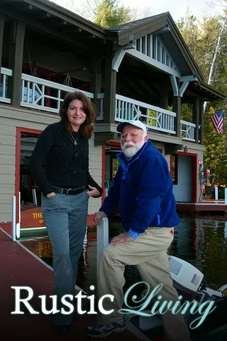











Support for PBS provided by:
Funding for ANTIQUES ROADSHOW is provided by Ancestry and American Cruise Lines. Additional funding is provided by public television viewers.



